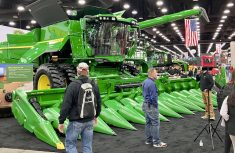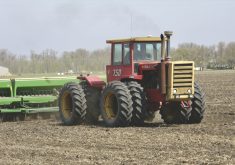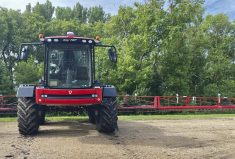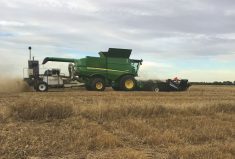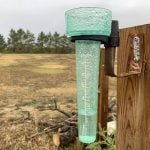Alberta ranchers Austin and his father Larry Ruud came up with an idea for a new product, the way any farmer faced with making things work day in and day out might, and the product that resulted is compostable baler net wrap which solves the problem of plastic twine and net wrap lasting for years and getting caught up in machines around a farm yard.
To help develop and bring that product to market, the Ruuds entered into a joint agreement between their startup firm, Nature’s Net Wrap, and CNH Ventures, the investing arm of the equipment manufacturer CNH Industrial and parent company behind Case IH and New Holland.
The compostable twine is being sold by Case IH and New Holland dealers starting this spring.
Read Also

What to consider when setting up farm-related business ventures
Things to consider before launching a farm-adjacent side business.
Increasingly, major equipment brands are keeping an eye out for young startup companies like Nature’s Net Wrap that have an innovative technology on their boards. And, as in this case, they are pumping investment money into them to help develop and incorporate that technology into their own product line.

“We launched CNH Ventures a couple of years ago,” points out Michele Lombardi, senior vice-president of corporate development at CNH. “Our purpose is joining forces with innovative teams of people that are working on disruptive technologies or new ideas, primarily in the ag tech space.”
Since starting, CNH Ventures has invested in 10 fledgling firms and bought another one outright, Lombardi says, “It’s a strategic investment… we invest to learn. And then, obviously, we seek a good financial return as well.”
“Sometimes we do some hires,” adds Lombardi. “We find a little team that has a good technology, good IP (intellectual property) or a good way of working and we just scoop them up and they are fully integrated into our teams as if they were always part of it. In some cases that’s the right thing to do.”
Although CNH’s prime objective isn’t to take over control of these firms or hire the individuals that populate them, they did buy Augmenta for its electronic eye technology, and increased their ownership share to 51 per cent in another.
Now, a similar strategy is underway in a slightly different program over at John Deere, which also looks to partner with small startups to enhance its R&D. Deere calls their program the Startup Collaborator, and in January it announced its list of six tech firms it will work with through the course of 2024 on a one-year term.
Deere launched the Startup Collaborator program in 2019, with a new group each calendar year.

“We’re really focused on mutual learning across the aisle in the companies, with the focus of solving customer problems in the field,” says Cody Sorge, business development manager with the Intelligent Solutions Group at John Deere.
“It’s a very light agreement we have,” Sorge emphasizes. “There’s no investment or IP involved. We get to work with these companies for a 12-month period, starting (each) January.
“They get a sponsor — or mentor — from the Deere team and a project lead to work with them. Then they go work on a project that is mutually beneficial… and we share information.”
Testing the limits
Whether you’re looking to do business with CNH or Deere, however, you’ll find that neither firm thinks of tech startups as a replacement for internal R&D. Instead, it’s a complementary or additional avenue to increase the number of technologies beyond what their in-house engineers can take on, especially the kinds of technologies that have been the main focus of the smaller companies.
The goal is for the big company to get a head start in the evolution of a product.
“Recently, this arm (CNH Ventures) has helped us to accelerate exploration of new spaces and to test some assumptions,” says Lombardi. “Before, we probably couldn’t do it as effectively because we would probably have had to acquire a company to do it or go through an entire internal development.
“It’s not replacing anything, it’s adding an additional option.”
The same is true at John Deere.
“What (Deere’s) program was founded for was finding opportunities with startup companies where technologies are being developed,” says Sorge, who goes on to describe what they’re looking for: “Really agile, focused teams that can move really quickly solving customer problems, making this technology available. Deere’s a large tech company. We might not be as focused or be able to move as quickly, so there’s a perfect opportunity to learn together.”
Who wins the contract?
Deere and CNH also have similar decision processes for figuring out which startups to work with. The main focus is on small firms that are working in the tech sector and have or are attempting to develop systems that could be a benefit to the larger companies.
“It’s a mix of things (we look for),” says Lombardi. “We predetermine some spaces we are interested in. It might be vision AI, it might robotics, these kinds of things. Once we have that direction, we then go out and build a map of all the players in that space. That creates a dynamic list of all the investments we could make and collaborate. We then go out and speak to many of them. In some cases they might not be interested. In some cases it might be the right target at the right time.
“We tend to work with a wider range of companies, not just the ones we invest in. We might start dialogue with these companies, even if we don’t invest.
“We look at how their technology is different from that around them. Why does that technology have a greater opportunity to be successful. We think how does that technology fit with our road map specifically? Going down the line, is this something we would be interested in including in our products? We participate in learning with those companies through an investment. If some of them become so interesting we think we should incorporate them, then we end up acquiring them.”
The investments made through the CNH Ventures initiative create a portfolio of small startups that can generate a financial return. In the case of Nature’s Net Wrap, it also adds a product that can be sold through CNH dealerships, although Lombardi says exclusivity in selling the products isn’t necessarily a requirement. In fact, CNH encourages the startups to forge their own way rather than limiting them.
“That’s a never-ending discussion we have internally,” Lombardi says. “All our companies, except one, have or will have in the future products that can be sold through our network. We do not force them to sell through our network. It’s potentially limiting to the growth of the companies, forcing them to only work with you. What happens is they lose that entrepreneurship. We drive them to develop their own commercial capability in order to be able to explore the world on their own. Through which, by the way, we learn too.”
At Deere, when it comes to selecting partners to collaborate with, the decision process follows a kind of parallel trajectory.
“Back in 2019 we asked, how can we get really connected to startups? How can we get them connected to us and learn together to see what’s possible?” says Sorge. “We start internally by looking at what we want to go and learn and what opportunities our customers have to solve. Then we’ll explore what companies are out there.
“It all starts at customers, identifying those areas of interest and then plugging in the right companies that fit. We want to make sure there are truly mutual benefits (for startups and Deere).”
Picking winners means taking a close look at more than just the advanced technologies that the startups are pursuing. It can be a bit of a Goldilocks story, finding the startups that are just right.
“We want to make sure they’re at the right stage,” says Sorge. “Making sure they’re early enough, a startup, and not too far along, they’re at the right stage. We’re trying to benefit each other in a win-win scenario.”
The big questions
“We clearly look at the management team,” adds Lombardi. “Do they have that spark in their eyes? Will they be able to continue the development or are they exhausted by what they’ve brought to the table and that’s it?
“If we invest, are they going to be loyal? Will they stay with the company or fly away like a butterfly and do something else? All these thoughts then become important elements in the decision-making, Are we going to put in some capital and commit longer term with these guys?”
Deere doesn’t extend the one-year time frame startups can stay in the Collaborator program, but neither does it rule out maintaining a relationship with a small firm that has impressed it. An example of a company that started off in the Collaborator program and ended up in the Deere family is Bear Flag Robotics in California. It’s a company that had been specializing in developing an add-on full autonomy system for Deere tractors. That is now the technology behind Deere’s autonomous 8R tractor offering, which is in the early stages of commercialization.
“There’s been companies invested in and acquired, even though that’s not the intent of what we’re trying to do,” says Sorge. “It’s really around go explore, learn and identify what we can learn together. And after that, see what happens. We try not to put a clear end on what happens.”
At all large organizations there can be a lot of top-down corporate standardization in procedures and rules regarding how things should be done. Inserting small agile, entrepreneurial firms with their own, often fast and loose processes can be a disruptor when it comes to how R&D gets done.
“We have our legacy approach, and the startups are blasphemous,” says Lombardi with a smile. “They go in and do things upside down and completely different. It’s a horror reaction from our team every time they see it. But it actually gets them thinking and makes them more agile, I think.
“Our ventures initiative is giving to CNH, as a team, far more than any potential financial return. It has truly accelerated our innovation capability by exposing us to different ideas and different ways of innovating.”
Both Lombardi and Sorge believe the approach has paid off, and each has major plans to continue their respective programs.
“I think it’s a wild success,” says Sorge. “At the end of year, we’re always blown away. It’s hard to go and measure, but I think in gaining awareness to technology, startups getting awareness to more customer problems to solve, awareness to Deere and how we work… those are the main measurements of success.”
Says Lombardi, “We like it. We’re learning a lot. It’s been successful. We’ll keep on investing.”




